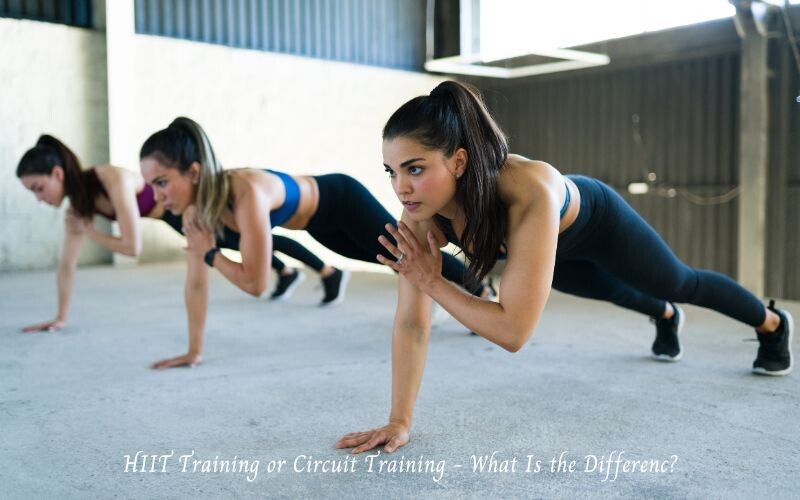When it comes to effective workout methods, the debate of HIIT vs Circuit Training often arises among fitness enthusiasts. They are both effective workout methods that can improve cardiovascular fitness, strength, and endurance. But they differ in their structure and focus.
Both High-Intensity Interval Training (HIIT) and circuit training offer unique benefits that can help you achieve your fitness goals, whether you’re aiming to build strength, improve cardiovascular health, or burn calories efficiently.
Understanding the key differences between these two popular workout styles can help you decide which best suits your needs. In this article, we’ll explore how HIIT and circuit training compare, so you can make an informed choice for your fitness routine.
Here’s a breakdown of the differences:
1. Structure and Focus
HIIT (High-Intensity Interval Training):
-
- Structure: HIIT involves alternating between short bursts of intense exercise (at or near your maximum effort) and periods of low-intensity exercise or rest.
- Focus: The primary goal of HIIT is to push your cardiovascular system and improve your aerobic and anaerobic fitness. Designed to maximize calorie burn and improve cardiovascular health in a shorter amount of time.
- Example: Sprinting for 30 seconds followed by 60 seconds of walking or rest, repeated for 15-20 minutes.
Circuit Training:
-
- Structure: Circuit training involves performing a series of different exercises in a sequence, one after the other, with minimal rest in between. Each “circuit” typically includes a mix of strength, endurance, and sometimes aerobic exercises.
- Focus: Circuit training is versatile and tailors to focus on strength, endurance, or a combination of both. Used for full-body workouts that improve muscle tone, strength, and endurance.
- Example: Performing 1 minute each of push-ups, squats, jumping jacks, and planks, then repeating the circuit 2-3 times.
2. Intensity
- HIIT: Typically involves higher intensity exercises with the goal of reaching near-maximum effort during the work intervals. Designed to challenge and push your limits.
- Circuit Training: It varies in intensity depending on the exercises chosen and the pace at which the circuit is performed. Less intense than HIIT but can be tailored to be more demanding.
3. Duration
- HIIT: Due to the high intensity, HIIT workouts are usually shorter, ranging from 15 to 30 minutes.
- Circuit Training: Circuit sessions can be longer, often lasting 30 to 60 minutes, depending on the number of circuits and exercises.
4. Rest Periods
- HIIT: Includes specific rest periods between intervals, which are essential to allow partial recovery before the next burst of high-intensity work.
- Circuit Training: May have minimal rest between exercises within a circuit, but there might be longer rest periods between each circuit.
5. Target Audience
- HIIT: Ideal for those who are looking to burn fat, improve cardiovascular health, and have limited time for workouts.
- Circuit Training: Provides a great, balanced workout. It combines strength and cardio for different fitness levels.
To Summarize
- HIIT is more about high intensity and short bursts, with the primary focus on cardiovascular conditioning and calorie burn.
- Circuit Training is a well-rounded approach that combines various exercises for a full-body workout, which can be more strength-focused or balanced with cardio elements.
Wrapping It Up
In the HIIT vs circuit training comparison, the best workout for you depends on your specific fitness goals and preferences.
HIIT is ideal for those seeking maximum calorie burn and improved cardiovascular fitness in a short amount of time.
Circuit training offers a more balanced approach to strength and endurance.
Both methods are highly effective, and incorporating elements of each into your routine can provide a well-rounded workout experience.
Ultimately, understanding the benefits of HIIT and circuit training will empower you to tailor your exercise regimen to achieve optimal results.
Both HIIT and Circuit Training are effective, and the choice between them depends on your fitness goals and preferences.
Disclaimer: If you have any concerns or questions about your health, you should always consult with a physician or other healthcare professional. No content on this site should be substituted for direct medical advice from your doctor or other qualified healthcare practitioner. The information contained here is for informational purposes only. It is from my research and personal experience.
Related Articles
Can You Do Circuit Weight Training Workouts At Home?
Can You Prevent Muscle Loss as You Age?
Low-Impact, High-Intensity Cardio Workouts For Better Health
Top 15 Benefits of Strength Training
Cardio, Strength, Balance, and Stability Exercises for Seniors

